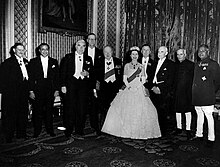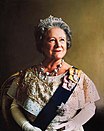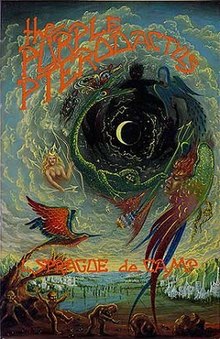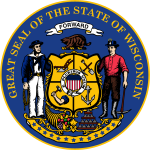파키스탄 자치령
Dominion of Pakistan파키스탄 | |||||||||
|---|---|---|---|---|---|---|---|---|---|
| 1947–1956[1] | |||||||||
| 국가: 콰미 타라나 (1954–56) | |||||||||
 짙은 녹색으로 표시된 파키스탄 자치령에 의해 통제되는 토지; 주장되지만 통제되지 않는 토지를 연두색으로 표시함 | |||||||||
| 자본의 | 카라치 | ||||||||
| 공용어 | 영어[i] | ||||||||
| 인정국어 | 우르두어[ii], 벵골어[iii] | ||||||||
| 데몬(들) | 파키스탄의 | ||||||||
| 정부 | 페더럴 의회의 입헌 군주제 | ||||||||
| 모나크 | |||||||||
• 1947–1952 | 조지 6세 | ||||||||
• 1952–1956 | 엘리자베스 2세 | ||||||||
| 총독부 | |||||||||
• 1947–1948 | 무함마드 알리 진나 | ||||||||
• 1948–1951 | 카와자 나지무딘 경 | ||||||||
• 1951–1955 | 굴람 무함마드 경 | ||||||||
• 1955–1956 | 이스칸데르 미르자 | ||||||||
| 수상 | |||||||||
• 1947–1951 | 리아콰트 알리 칸 | ||||||||
• 1951–1953 | 카와자 나지무딘 경 | ||||||||
• 1953–1955 | 모하마드 알리 보그라 | ||||||||
• 1955–1956 | 초드리 모하마드 알리 | ||||||||
| 입법부 | 제헌의회 | ||||||||
| 역사 | |||||||||
• 인디펜던스 | 1947년8월14일[2] | ||||||||
• 이슬람 공화국 | 1956년3월23일 | ||||||||
| 지역 | |||||||||
• 토탈 | 1,030,373 km2 (397,829 평방 마일) | ||||||||
| 통화 | 인도 루피 (1947-1948) 파키스탄 루피 (1948-1956) | ||||||||
| |||||||||
| 오늘의 일부 | 파키스탄 방글라데시 [a] | ||||||||
파키스탄 자치령([3]Pakistan Dominion of Pakistan)은 1947년 8월 14일부터 1956년 3월 23일까지 존재했던 영국 연방의 독립적인 자치령으로 영국 의회에 의해 1947년 인도 독립법이 통과되면서 탄생했습니다.
독립 이전에 파키스탄은 인도 분할에서 할당된 영국령 인도의 대통령과 지방으로 구성되었습니다.1947년까지, 그들은 대영제국의 일부분으로서 영국에 의해 지배를 받았습니다.
독립 이후 한 해 동안, 새로운 국가는 이전에 영국과 보조 동맹을 맺고 있던 왕자들이 통치하는 파키스탄의 왕자 국가들과 합류했습니다. 왕자들은 그들의 통치자들이 가입 조항에 서명하면서 하나씩 파키스탄에 가입했습니다.여러 해 동안, 이 주들은 지배권 안에서 특별한 지위를 누렸고 나중에는 공화국 안에서 특별한 지위를 누렸지만, 그들은 서서히 지방에 편입되었습니다.그들 내부 자치 정부의 마지막 잔재는 1974년에 이르러 사라졌습니다.
처음에 파키스탄 자치령은 두 개의 날개를 가지고 있었는데, 하나는 현재 방글라데시인 동쪽에, 다른 하나는 현재 파키스탄인 서쪽에 있었습니다.1956년 파키스탄 헌법이 발효된 후, 파키스탄 이슬람 공화국이 선포되면서 파키스탄 군주제는 폐지되었습니다.
1956년 파키스탄 헌법이 완성되면서 대영제국 내 연방 지배국의 지위는 막을 내리게 되었고, 이로써 파키스탄은 공화국이 되었습니다.헌법은 또한 행정적으로 서파키스탄과 동파키스탄으로 분리되었는데, 서파키스탄은 그 당시까지 단일한 독립체로 통치되어 왔습니다.1971년 인도-파키스탄 전쟁 이후 동파키스탄은 방글라데시의 새로운 국가로 분리되었고 서파키스탄은 파키스탄이 되었습니다.
역사
분할 및 독립
1947년 인도 독립법 제1조는 "1947년 8월 15일부터 인도에 두 개의 독립된 영토가 세워지고 각각 인도와 파키스탄으로 알려지게 된다"고 규정했습니다.영국 군주는 영국 및 영연방의 다른 지배권들과 함께 왕을 공유하고, 파키스탄에서 군주의 헌법상 역할은 파키스탄 총독에게 위임되는 등 새로운 지배권들의 국가 원수가 되었습니다.
1947년 8월 이전에, 오늘날 파키스탄의 지역의 약 절반은 영국 왕실의 이름으로 영국이 직접 통치하고 있던 영국령 인도의 일부였고, 나머지는 반자치적인 자치 정부를 누리며 영국과 보조 동맹을 맺고 있는 군주국이었습니다.영국은 1947년 8월에 이러한 동맹을 포기하고 주들을 완전히 독립시켰고, 1947년과 1948년 사이에 주들은 모두 파키스탄에 가입하면서 몇 년 동안 내부 자치 정부를 유지했습니다.
펀자브 지역에서는 1천만 명 이상의 사람들이 새로운 국경을 넘어 이주했으며, 200,000명에서 200,000[4][5][6][7],000명 사이의 사람들이 펀자브 지역에서 발생한 집단 폭력 사태로 사망했습니다. 일부 학자들은 이를 종교 간의 '응보적 대량학살'이라고 설명했습니다.[8]파키스탄 정부는 50,000명의 이슬람 여성들이 힌두교와 시크교도 남성들에게 납치되어 강간당했다고 주장했고 인도 정부도 마찬가지로 이슬람교도들이 33,000명의 힌두교와 시크교도 여성들을 납치하고 강간했다고 주장했습니다.[9][10][11]양국 정부는 납치된 여성들을 송환하기로 합의했고, 수천 명의 힌두교, 시크교, 이슬람교도 여성들이 1950년대에 가족들에게 송환되었습니다.카슈미르를 둘러싼 분쟁은 인도와 파키스탄 사이의 1차 전쟁으로 확대되었습니다.유엔의 도움으로 전쟁은 끝났지만 2022년[update] 현재 해결되지 않은 카슈미르 분쟁이 되었습니다.
1947년, 파키스탄의 건국 아버지들은 리아콰트 알리 칸을 초대 총리로 임명하기로 합의했고, 무하마드 알리 진나를 초대 총독과 주 의회 의장으로 모두 임명했습니다.[12]마운트배튼은 인도와 파키스탄의 총독직을 제안했지만 진나는 이 제안을 거절했습니다.[13]
파키스탄을 이념적인 이슬람 국가로 변화시키기 위한 첫 번째 공식적인 조치는 1949년 3월 리아콰트 알리 칸이 제헌의회에서 목표 결의를 도입했을 때 취했습니다.목표결의안은 우주 전체에 대한 주권은 알라에게 있다고 선언했습니다.목표결의안과 파키스탄의 이슬람국가 전환에 대한 지지는 1949년 파키스탄에서 샤이크 알 이슬람의 위치를 차지한 존경받는 데반디 알림(학자) 마울라나 샤비르 아마드 우스마니와 자마트이 이슬라미의 마울라나 마우두디가 주도했습니다.[14][15]
미국, 봄베이 지방, 중부 지방과 인도의 다른 지역에서 온 인도 이슬람교도들은 1950년대와 1960년대 내내 파키스탄으로 이주를 계속했고, 신드 도시, 특히 새로운 국가의 첫 수도인 카라치에 주로 정착했습니다.[16]알리 칸 총리는 강력한 정부를 수립했고, 정권을 잡은 직후부터 시련에 직면해야 했습니다.[12]그의 재무장관 빅터 터너는 미국의 통계 지식, 재정, 세금, 그리고 세입 징수를 향상시키기 위해 주 은행, 연방 통계국, 그리고 연방 세입 위원회를 설립함으로써 나라의 첫 번째 통화 정책을 발표했습니다.[17]또한 인도가 1948년 4월 1일 펀자브 지역의 두 개의 운하 건설에서 파키스탄에 대한 물 공급을 차단하고 인도 정부가 간디의 압력 이후 공개한 연합 인도의 자산과 자금에 대한 인도의 몫을 파키스탄에 전달하는 것을 보류했기 때문에 문제가 있었습니다.[18]
정정 불안
1948년 연설에서 진나는 "우르두어만이 파키스탄의 주 언어이자 링구아 프랑카가 될 것"이라고 선언했지만 동시에 벵골어가 벵골 지방의 공용어가 될 것을 요구했습니다.[19]그럼에도 불구하고 동벵골주에서는 긴장이 고조되기 시작했습니다.[19]진나의 건강은 더욱 악화되어 1948년에 세상을 떠났습니다.벵골의 지도자인 카와자 나지무딘 경은 파키스탄의 총독직을 승계했습니다.[20]
1951년 대규모 정치 집회 중 알리 칸 총리가 암살되고 나지무딘이 두 번째 총리가 되었습니다.[12]동파키스탄의 긴장은 1952년 동파키스탄 경찰이 벵골어를 우르두어와 동등한 지위를 받기 위해 시위하는 학생들에게 발포하면서 절정에 이르렀습니다.상황은 1956년 헌법에서 성문화된 권리인 벵골어에 동등한 지위를 부여하는 포기를 내린 나지무딘에 의해 통제되었습니다.1953년 종교 정당들의 선동으로 반 아마디야 폭동이 일어났고, 이로 인해 많은 아마디가 사망했습니다.[21]폭동은 1954년 2명으로 구성된 조사 법원에 의해 조사되었으며,[22] 폭동을 선동한 혐의로 기소된 당사자 중 하나인 자마트-e-이슬람은 이를 비난했습니다.[23]이 사건은 전국 최초의 계엄령으로 이어졌고, 국가의 정치와 민간 문제에 대한 군사 개입의 역사를 시작했습니다.[24]1954년에 논란이 된 원 유닛 프로그램은 마지막 파키스탄 무슬림 연맹(PML) 총리 알리 보그라가 독일의 지정학적 모델에 따라 파키스탄을 분열시킨 것입니다.[25]같은 해 파키스탄에서 최초의 국회의원 선거가 열렸는데, 이 선거에서 공산주의자들이 동파키스탄을 장악하게 되었습니다.[26]1954년 선거 결과는 서파키스탄과 동파키스탄의 이념 차이를 명확히 하였고, 동파키스탄은 슈라마익 크리삭 사마즈바디 달(노동자당)과 아와미 동맹의 공산당의 영향 하에 있었습니다.[26]친미 성향의 공화당은 서파키스탄에서 다수당을 차지해 PML 정부를 축출했습니다.[26]파키스탄을 이슬람 공화국으로 확정한 1956년 헌법이 공포되고 의회 신임투표를 거쳐, 두 명의 주목할 만한 인물이 이 나라의 첫 벵골 지도자로서 총리와 대통령이 되었습니다.후세인 수라와디는 공산주의-사회주의 동맹을 이끄는 총리가 되었고, 이스칸데르 미르자는 파키스탄의 첫 번째 대통령이 되었습니다.[27]
래드클리프 선과 준주

 무슬림 연맹의 깃발로 구성된 마운트배튼이 제안한 파키스탄 국기는 광동에서 유니언 잭으로 훼손되었습니다.
무슬림 연맹의 깃발로 구성된 마운트배튼이 제안한 파키스탄 국기는 광동에서 유니언 잭으로 훼손되었습니다.지배권은 5개의 속주로 이루어진 연방으로 시작되었습니다.동벵골주(나중에 방글라데시가 됨), 서펀자브주, 발로치스탄주, 신드주, 북서프런티어주(NWFP).각 지방에는 파키스탄 총독이 임명한 고유의 주지사가 있었습니다.게다가, 그 다음 해에 서파키스탄의 상당한 지역을 차지했던 파키스탄의 군주국들이 파키스탄에 진출했습니다.그들은 바하왈푸르, 카이르푸르, 스와트, 디르, 치트랄, 그리고 칼라트 칸국을 포함했습니다.
1947년 8월 17일까지 출판되지 않은 논란의 여지가 있는 래드클리프 상은 인도와 파키스탄의 두 개의 새로운 독립 영토에 할당된 영국령 인도의 부분 사이의 경계를 획정한 래드클리프 선을 명시했습니다.래드클리프 경계위원회는 동부와 북서부의 이슬람교도가 다수인 지역과 힌두교가 다수인 지역을 분리하려고 했습니다.이것은 균일한 다수를 차지하지 못했던 벵골과 펀자브라는 영국의 두 지방의 분할을 수반했습니다.펀자브의 서부는 파키스탄 펀자브 주가 되었고 동부는 인도 펀자브 주가 되었습니다.벵골은 파키스탄의 동벵골과 인도의 서벵골로 비슷하게 나뉘었습니다.
군주제와 영연방

1947년 인도 독립법에 따라 영국령 인도는 인도와 파키스탄의 독립 주권국으로 분할되었습니다.1947년부터 1952년까지 조지 6세는 영국 및 영국 영연방의 다른 도미니언들과 같은 사람을 공유한 파키스탄의 군주였습니다.[28][29]
1952년 2월 6일 조지 6세가 서거한 후, 당시 케냐에 있던 그의 장녀 엘리자베스 공주가 파키스탄의 새 군주가 되었습니다.1953년 여왕의 대관식 동안, 엘리자베스 2세는 파키스탄을 포함한 7개의 독립 영연방 국가들의 여왕으로 즉위했습니다.[30]대관식 선서에서 새 여왕은 "...의 국민들을 통치하겠다"고 약속했습니다.파키스탄은 각각의 법과 관습에 따라"[31]대관식에서의 파키스탄 기준은 미르자 아볼 하산 이스파하니가 지었습니다.[32]
파키스탄은 1956년 3월 23일 공화제 헌법을 채택하면서 군주제를 폐지했습니다.[33]하지만 파키스탄은 영연방 내에서 공화국이 되었습니다.여왕은 미르자 대통령에게 메시지를 보내 "나는 당신의 나라가 건국된 이래로 발전해 온 것에 깊은 관심을 가지고 따라왔습니다.나는 당신의 나라가 영연방에 남아 있으려 한다는 것을 알고 매우 만족스럽게 생각합니다.저는 파키스탄과 영연방의 다른 국가들이 계속해서 번영하고 그들의 상호 연관으로부터 이익을 얻을 것이라고 확신합니다."[34]
대외관계

1949년 파키스탄-아프가니스탄 국경을 둘러싼 이웃 아프가니스탄과 카슈미르의 통제선을 둘러싼 인도 사이에 영토 문제가 발생했습니다.[12]조셉 스탈린이 이끄는 소련이 파키스탄과 인도를 세운 분단을 환영하지 않자 외교적 인정이 문제가 됐습니다.이란 제국은 1947년 파키스탄을 인정한 최초의 국가였습니다.[35]1948년 이스라엘의 벤구리온이 외교관계 수립을 위해 비밀 택배를 진나에게 보냈지만 진나는 벤구리온에게 아무런 답변을 하지 않았습니다.
독립 이후 파키스탄은 다른 이슬람 국가들과의[36] 관계를 적극적으로 추구했고, 이슬람 세계의 지도자, 혹은 최소한 통합을 이루기 위한 지도자들을 위해 진심으로 노력했습니다.[37]알리 형제는 파키스탄을 이슬람 세계의 자연적인 지도자로 투영하려고 했는데, 상당 부분 파키스탄의 인구와 군사력 덕분이었습니다.[38]이슬람 연맹의 최고위 지도자인 칼리퀴자만은 파키스탄이 모든 이슬람 국가들을 범이슬람 단체인 이슬람으로 통합할 것이라고 선언했습니다.[39]파키스탄의 창설을 찬성하지 않았던 미국은 이에 반대했고, 당시 클레멘트 애틀리 영국 총리는 무슬림 세계의 통합을 희망하는 것과 달리 인도와 파키스탄의 재통합을 희망한다고 언급하며 국제적인 의견을 표명했습니다.[40]당시 아랍 세계의 대부분이 민족주의적 각성을 겪고 있었기 때문에 파키스탄의 범이슬람적 열망에는 별 관심이 없었습니다.[41]일부 아랍 국가들은 '이슬람 국가' 프로젝트를 파키스탄이 다른 이슬람 국가들을 지배하려는 시도로 보고 있습니다.[42]파키스탄은 전세계 이슬람교도들의 자기결정권을 강력하게 옹호했습니다.인도네시아, 알제리, 튀니지, 모로코, 에리트레아의 독립운동을 위한 파키스탄의 노력은 중요했고, 처음에는 이 나라들과 파키스탄 간의 긴밀한 유대관계로 이어졌습니다.[43]
국가 원수 목록
모나크스
1947년부터 1956년까지 파키스탄은 입헌군주제였습니다.파키스탄 군주는 영국 영연방의 국가들의 군주와 같은 사람이었습니다.[44][29]
| 초상화 | 이름. | 출생. | 재위 | 죽음. | 컨소시엄 | 전임자와의 관계 | 왕가 |
|---|---|---|---|---|---|---|---|
 | 조지 6세 | 1895년12월14일 | 1947년8월14일 – 1952년2월6일 | 1952년2월6일 |  | 없음(위치 생성);분할 이전의 인도 황제 | 윈저 |
 | 엘리자베스 2세 | 1926년 4월 21일 | 1952년2월6일 – 1956년3월23일 | 2022년9월8일 |  | 조지 6세의 딸 |
총독부
총독은 파키스탄 자치령의 군주의 대표였습니다.[45]
| 사진. | 이름. (탄생사망) | 취임 | 레프트 오피스 | 임명자 |
|---|---|---|---|---|
 | 무함마드 알리 진나 (1876–1948) | 1947년8월15일 | 1948년9월11일 |  |
 | 카와자 나지무딘 경 (1894–1964) | 1948년9월14일 | 1951년10월17일 | |
 | 굴람 무함마드 경 (1895–1956) | 1951년10월17일 | 1955년8월7일 | |
 | ||||
 | 이스칸데르 미르자 (1899–1969) | 1955년8월7일 | 1956년3월23일 |
참고 항목
메모들
- ^ 인도와 방글라데시(인도-방글라데시 지역) 간의 영토 교류 참조.
참고문헌
- ^ Timothy C. Winegard (29 December 2011). Indigenous Peoples of the British Dominions and the First World War (1st ed.). Cambridge University Press. p. 2. ISBN 978-1107014930. Archived from the original on 17 January 2023. Retrieved 11 August 2013.
- ^ Singh Vipul (1 September 2009). Longman History & Civics Icse 10. Pearson Education India. pp. 132–. ISBN 978-81-317-2042-4. Archived from the original on 17 January 2023. Retrieved 9 November 2015.
- ^ 공식 명칭은 "파키스탄의 지배"가 아닌 "파키스탄"입니다.1947년 인도독립법 제1절-(i)1947년 8월 15일부터 인도에 독립된 2개의 지배구역이 설치되어 각각 인도와 파키스탄으로 알려지게 됩니다."
- ^ Talbot, Ian (2009). "Partition of India: The Human Dimension". Cultural and Social History. 6 (4): 403–410. doi:10.2752/147800409X466254. S2CID 147110854.
The number of casualties remains a matter of dispute, with figures being claimed that range from 200,000 to 2 million victims.
- ^ "Murder, rape and shattered families: 1947 Partition Archive effort underway". Dawn. 13 March 2015. Archived from the original on 14 February 2017. Retrieved 14 January 2017.
There are no exact numbers of people killed and displaced, but estimates range from a few hundred thousand to two million killed and more than 10 million displaced.
- ^ Basrur, Rajesh M. (2008). South Asia's Cold War: Nuclear Weapons and Conflict in Comparative Perspective. Routledge. ISBN 978-1-134-16531-5. Archived from the original on 16 January 2023. Retrieved 24 October 2021.
An estimated 12–15 million people were displaced, and some 2 million died. The legacy of Partition (never without a capital P) remains strong today ...
- ^ Isaacs, Harold Robert (1975). Idols of the Tribe: Group Identity and Political Change. Harvard University Press. ISBN 978-0-674-44315-0. Archived from the original on 16 January 2023. Retrieved 24 October 2021.
2,000,000 killed in the Hindu-Muslim holocaust during the partition of India and the creation of Pakistan
- ^ Brass, Paul R. (2003). "The partition of India and retributive genocide in the Punjab, 1946–47: means, methods, and purposes" (PDF). Journal of Genocide Research. Carfax Publishing: Taylor and Francis Group. pp. 81–82 (5(1), 71–101). Archived from the original (PDF) on 19 March 2015. Retrieved 16 August 2014.
In the event, largely but not exclusively as a consequence of their efforts, the entire Muslim population of the eastern Punjab districts migrated to West Punjab and the entire Sikh and Hindu populations moved to East Punjab in the midst of widespread intimidation, terror, violence, abduction, rape, and murder.
- ^ Daiya, Kavita (2011). Violent Belongings: Partition, Gender, and National Culture in Postcolonial India. Temple University Press. p. 75. ISBN 978-1-59213-744-2. Archived from the original on 16 January 2023. Retrieved 24 October 2021.
The official estimate of the number of abducted women during Partition was placed at 33,000 non-Muslim (Hindu or Sikh predominantly) women in Pakistan, and 50,000 Muslim women in India.
- ^ Singh, Amritjit; Iyer, Nalini; Gairola, Rahul K. (2016). Revisiting India's Partition: New Essays on Memory, Culture, and Politics. Lexington Books. p. 14. ISBN 978-1-4985-3105-4. Archived from the original on 16 January 2023. Retrieved 24 October 2021.
The horrific statistics that surround women refugees-between 75,000–100,000 Hindu, Muslim and Sikh women who were abducted by men of the other communities, subjected to multiple rapes, mutilations, and, for some, forced marriages and conversions-is matched by the treatment of the abducted women in the hands of the nation-state. In the Constituent Assembly in 1949 it was recorded that of the 50,000 Muslim women abducted in India, 8,000 of then were recovered, and of the 33,000 Hindu and Sikh women abducted, 12,000 were recovered.
- ^ Abraham, Taisha (2002). Women and the Politics of Violence. Har-Anand Publications. p. 131. ISBN 978-81-241-0847-5. Archived from the original on 16 January 2023. Retrieved 24 October 2021.
In addition thousands of women on both sides of the newly formed borders (estimated range from 29,000 to 50,000 Muslim women and 15,000 to 35,000 Hindu and Sikh women) were abducted, raped, forced to convert, forced into marriage, forced back into what the two States defined as 'their proper homes,' torn apart from their families once during partition by those who abducted them, and again, after partition, by the State which tried to 'recover' and 'rehabilitate' them.
- ^ a b c d "Government of Prime Minister Liaquat Ali Khan". Story of Pakistan press (1947 Government). June 2003. Archived from the original on 7 April 2013. Retrieved 17 April 2013.
- ^ Wolpert, Stanley (2009). Shameful Flight: The Last Years of the British Empire in India. Oxford University Press. p. 163. ISBN 978-0-19-974504-3. Archived from the original on 16 January 2023. Retrieved 24 October 2021.
Mountbatten tried to convince Jinnah of the value of accepting him, Mountbatten, as Pakistan's first governor-general, but Jinnah refused to be moved from his determination to take that job himself.
- ^ Hussain, Rizwan. "Pakistan". The Oxford Encyclopedia of the Islamic World. Archived from the original on 29 March 2016. Retrieved 23 March 2017.
Mawlānā Shabbīr Ahmad Usmānī, a respected Deobandī ʿālim (scholar) who was appointed to the prestigious position of Shaykh al-Islām of Pakistan in 1949, was the first to demand that Pakistan become an Islamic state. But Mawdūdī and his Jamāʿat-i Islāmī played the central part in the demand for an Islamic constitution. Mawdūdī demanded that the Constituent Assembly make an unequivocal declaration affirming the "supreme sovereignty of God" and the supremacy of the sharīʿah as the basic law of Pakistan.
- ^ Hussain, Rizwan. "Pakistan". The Oxford Encyclopedia of the Islamic World. Archived from the original on 29 March 2016. Retrieved 23 March 2017.
The first important result of the combined efforts of the Jamāʿat-i Islāmī and the ʿulamāʿ was the passage of the Objectives Resolution in March 1949, whose formulation reflected compromise between traditionalists and modernists. The resolution embodied "the main principles on which the constitution of Pakistan is to be based." It declared that "sovereignty over the entire universe belongs to God Almighty alone and the authority which He has delegated to the State of Pakistan through its people for being exercised within the limits prescribed by Him is a sacred trust," that "the principles of democracy, freedom, equality, tolerance and social justice, as enunciated by Islam shall be fully observed," and that "the Muslims shall be enabled to order their lives in the individual and collective spheres in accord with the teaching and requirements of Islam as set out in the Holy Qurʿan and Sunna." The Objectives Resolution has been reproduced as a preamble to the constitutions of 1956, 1962, and 1973.
- ^ KHALIDI, OMAR (1 January 1998). "From Torrent to Trickle: Indian Muslim Migration to Pakistan, 1947—97". Islamic Studies. 37 (3): 339–352. JSTOR 20837002.
- ^ Chaudry, Aminullah (2011). Political administrators : the story of the Civil Service of Pakistan. Oxford: Oxford University Press. ISBN 978-0-19-906171-6.
- ^ Aparna Pande (16 March 2011). Explaining Pakistan's Foreign Policy: Escaping India. Taylor & Francis. pp. 16–17. ISBN 978-1-136-81894-3. Archived from the original on 16 January 2023. Retrieved 24 October 2021.
- ^ a b Yasser Latif Hamdani (22 February 2010). "Jinnah And Urdu-Bengali Controversy". Pakistan Tea House. Archived from the original on 16 March 2013. Retrieved 17 April 2013.
- ^ Administration. "Khawaja Nazimuddin Becomes Governor General". Administration. Archived from the original on 30 March 2017. Retrieved 23 March 2017.
- ^ Blood, Peter R. (1995). Pakistan: a country study. Washington, D.C.: Federal Research Division, Library of Congress. pp. 130–131. ISBN 978-0-8444-0834-7.
Pakistan: A Country Study.
- ^ Munir, Muhammad; Malik Rustam Kayani (1954). Punjab. Court of Inquiry to Enquire into the Punjab Disturbances of 1953 (PDF). Lahore: Superintendent, Government Printing, Punjab. Archived (PDF) from the original on 10 January 2017. Retrieved 23 March 2017.
- ^ Ahmad, Khurshid (1956). An Analysis of the Munir report; a critical study of the Punjab disturbances inquiry report. Karachi: Jamaat-e-Islami Publications.
- ^ Rizvi, Hasan Askari (1974). The military and politics in Pakistan. Lahore: Progressive Publishers.
- ^ "One Unit Program". One Unit. June 2003. Archived from the original on 11 April 2013. Retrieved 17 April 2013.
- ^ a b c Jaffrelot, Christophe, ed. (2004). A history of Pakistan and its origins. Translated by Beaumont, Gillian (New ed.). London: Anthem. ISBN 1-84331-149-6.
- ^ Blood, Peter R. (1995). Pakistan: a country study. Washington, D.C.: Federal Research Division, Library of Congress. p. 41. ISBN 978-0-8444-0834-7.
Pakistan: A Country Study.
- ^ Matthew, H. C. G. (September 2004). "George VI". Oxford Dictionary of National Biography (online ed.). Oxford University Press. doi:10.1093/ref:odnb/33370. Retrieved 20 April 2008.
India and Pakistan remained among the king's dominions but both were set on republican courses, becoming republics within the Commonwealth in 1950 and 1956 respectively.
(구독 또는 영국 공공도서관 회원 자격 필요) - ^ a b Kumarasingham, Harshan (2013), THE 'TROPICAL DOMINIONS': THE APPEAL OF DOMINION STATUS IN THE DECOLONISATION OF INDIA, PAKISTAN AND CEYLON, vol. 23, Transactions of the Royal Historical Society, p. 223, JSTOR 23726109, archived from the original on 13 January 2022, retrieved 7 July 2021
- ^ "The Coronation of Queen Elizabeth II". YouTube. Archived from the original on 21 December 2021. Retrieved 16 May 2014.
- ^ "The Form and Order of Service that is to be performed and the Ceremonies that are to be observed in the Coronation of Her Majesty Queen Elizabeth II in the Abbey Church of St. Peter, Westminster, on Tuesday, the second day of June, 1953". Oremus.org. Archived from the original on 7 October 2016. Retrieved 3 February 2013.
- ^ "Page 6240 Supplement 40020, 17 November 1953 London Gazette The Gazette". www.thegazette.co.uk. Archived from the original on 14 August 2021. Retrieved 28 April 2022.
- ^ John Stewart Bowman (2000). Columbia chronologies of Asian history and culture. Columbia University Press. p. 372. ISBN 978-0-231-11004-4. Retrieved 22 March 2011.
- ^ Pakistan Affairs. Information Division, Embassy of Pakistan. 1956. p. 7. Archived from the original on 17 January 2023. Retrieved 28 April 2022.
- ^ "See: Iran-Pakistan relations".
- ^ Pasha, Sayed Abdul Muneem (2005). Islam in Pakistan's foreign policy. Global Media Publications. p. 225. ISBN 978-81-88869-15-2. Archived from the original on 16 January 2023. Retrieved 24 October 2021.
Pakistan's expression of solidarity was followed, after Independence, by a vigorous pursuit of bilateral relations with Muslim countries like Iran and Turkey.
- ^ Pasha, Sayed Abdul Muneem (2005). Islam in Pakistan's foreign policy. Global Media Publications. p. 37. ISBN 978-81-88869-15-2. Archived from the original on 16 January 2023. Retrieved 24 October 2021.
Pakistan was making a wholehearted bid for the leadership of the Muslim world, or at least for the leadership in achieving its unity.
- ^ Pasha, Sayed Abdul Muneem (2005). Islam in Pakistan's foreign policy. Global Media Publications. p. 226. ISBN 978-81-88869-15-2. Archived from the original on 16 January 2023. Retrieved 24 October 2021.
Following Khaliquzzaman, the Ali brothers had sought to project Pakistan, with its comparatively larger manpower and military strength, as the natural leader of the Islamic world.
- ^ Dhulipala, Venkat (2015). Creating a New Medina. Cambridge University Press. p. 18. ISBN 978-1-107-05212-3. Archived from the original on 16 January 2023. Retrieved 24 October 2021.
As a top ranking ML leader Khaliquzzaman declared, 'Pakistan would bring all Muslim countries together into Islamistan- a pan-Islamic entity'.
- ^ Haqqani, Husain (2013). Magnificent Delusions: Pakistan, the United States, and an Epic History of Misunderstanding. PublicAffairs. pp. 20–21. ISBN 978-1-61039-317-1. Archived from the original on 16 January 2023. Retrieved 24 October 2021.
Within a few years the president of the Muslim League, Chaudhry Khaliq-uz-Zaman, announced that Pakistan would bring all Muslim countries together into Islamistan-a pan-Islamic entity. None of these developments within the new country elicited approval among Americans for the idea of India's partition ... British Prime Minister Clement Attlee voiced the international consensus at the time when he told the House of Commons of his hope that 'this severance may not endure.' He hoped that the proposed dominions of India and Pakistan would "in course of time, come together to form one great member state of the British Commonwealth of Nations."
- ^ Haqqani, Husain (2013). Magnificent Delusions: Pakistan, the United States, and an Epic History of Misunderstanding. PublicAffairs. p. 22. ISBN 978-1-61039-317-1. Archived from the original on 12 May 2017. Retrieved 23 March 2017.
During this time most of the Arab world was going through a nationalist awakening. Pan-Islamic dreams involving the unification of Muslim countries, possibly under Pakistani leadership, had little attraction.
- ^ Roberts, Jeffery J. (2003). The Origins of Conflict in Afghanistan. Greenwood Publishing Group. p. 134. ISBN 978-0-275-97878-5. Archived from the original on 16 January 2023. Retrieved 24 October 2021.
The following year, Choudhry Khaliquzzaman toured the Middle East, pleading for the formation of an alliance or confederation of Muslim states. The Arab states, often citing Pakistan's inability to solve its problems with Muslim neighbor Afghanistan, showed little enthusiasm ... Some saw the effort to form 'Islamistan' as a Pakistani attempt to dominate other Muslim states.
- ^ Pande, Aparna (2011). Explaining Pakistan's Foreign Policy: Escaping India. Routledge. ISBN 978-1-136-81893-6. Archived from the original on 16 January 2023. Retrieved 24 October 2021.
The belief that the creation of Pakistan made Pakistan the true leader of Muslim causes around the world led Pakistan's diplomats to vigorously champion the cause of self-determination for fellow Muslims at the United Nations. Pakistan's founders, including Jinnah, supported anti-colonial movements: Our heart and soul go out in sympathy with those who are struggling for their freedom ... If subjugation and exploitation are carried on, there will be no peace and there will be no end to wars. Pakistani efforts on behalf of Indonesia (1948), Algeria (1948–1949), Tunisia (1948–1949), Morocco (1948–1956) and Eritrea (1960–1991) were significant and initially led to close ties between these countries and Pakistan.
- ^ Winegard, Timothy C. (2011), Indigenous Peoples of the British Dominions and the First World War, Cambridge University Press, p. 2, ISBN 978-1-107-01493-0, archived from the original on 17 January 2023, retrieved 18 August 2019
- ^ Chief Justice Muhammad Munir: His Life, Writings, and Judgements, Research Society of Pakistan, 1973, p. 341
추가열람
- Chester, Lucy P. (2009) 남아시아의 국경과 분쟁: 래드클리프 경계위원회와 펀자브 분할.맨체스터:맨체스터 대학 출판부.
- 읽기, A.와 피셔, D. (1997).가장 자랑스러운 날: 인도의 독립을 향한 먼 길.뉴욕: 노튼.




